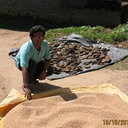Cold tolerance response mechanisms revealed through comparative analysis of gene and protein expression in multiple rice genotypes.
Mots clés
Abstrait
Due to its tropical origin and adaptation, rice is significantly impacted by cold stress, and consequently sustains large losses in growth and productivity. Currently, rice is the second most consumed cereal in the world and production losses caused by extreme temperature events in the context of "major climatic changes" can have major impacts on the world economy. We report here an analysis of rice genotypes in response to low-temperature stress, studied through physiological gas-exchange parameters, biochemical changes in photosynthetic pigments and antioxidants, and at the level of gene and protein expression, towards an understanding and identification of multiple low-temperature tolerance mechanisms. The first effects of cold stress were observed on photosynthesis among all genotypes. However, the tropical japonica genotypes Secano do Brazil and Cypress had a greater reduction in gas exchange parameters like photosynthesis and water use efficiency in comparison to the temperate japonica Nipponbare and M202 genotypes. The analysis of biochemical profiles showed that despite the impacts of low temperature on tolerant plants, they quickly adjusted to maintain their cellular homeostasis by an accumulation of antioxidants and osmolytes like phenolic compounds and proline. The cold tolerant and sensitive genotypes showed a clear difference in gene expression at the transcript level for OsGH3-2, OsSRO1a, OsZFP245, and OsTPP1, as well as for expression at the protein level for LRR-RLKs, bHLH, GLYI, and LTP1 proteins. This study exemplifies the cold tolerant features of the temperate japonica Nipponbare and M202 genotypes, as observed through the analysis of physiological and biochemical responses and the associated changes in gene and protein expression patterns. The genes and proteins showing differential expression response are notable candidates towards understanding the biological pathways affected in rice and for engineering cold tolerance, to generate cultivars capable of maintaining growth, development, and reproduction under cold stress. We also propose that the mechanisms of action of the genes analyzed are associated with the tolerance response.



